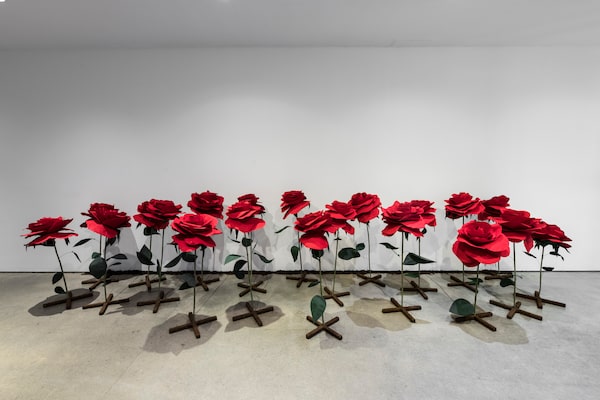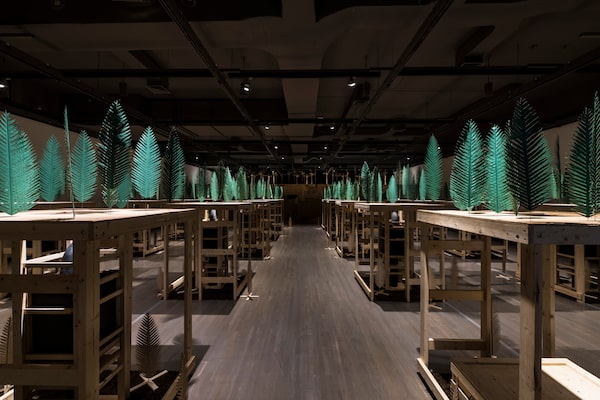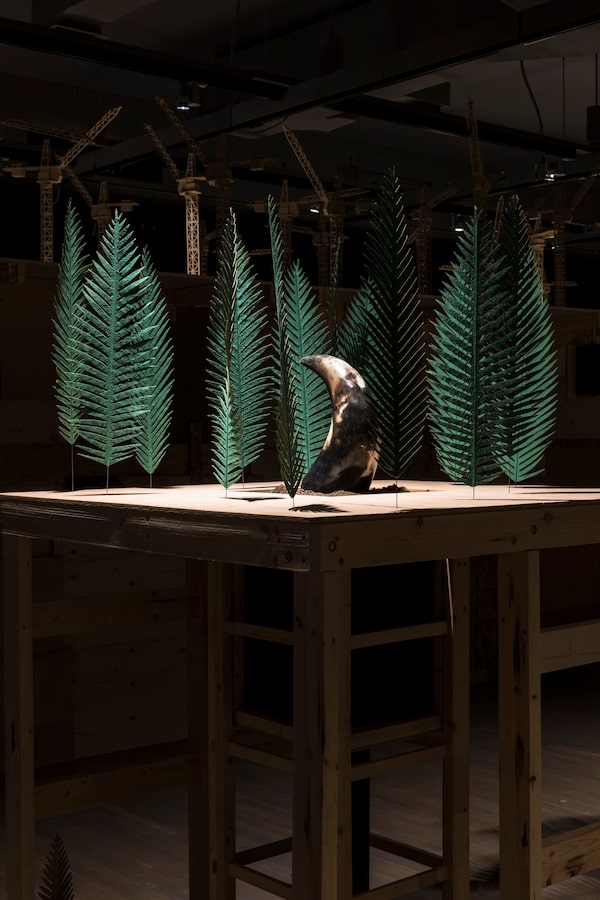
'They’re friends,' Rita McKeough says of the rose sculptures that greet visitors in the lobby of this show.Donald Lee/Handout
The multidisciplinary artist Rita McKeough is worried about the world – particularly the land, and plants and animals that rely on it. She has channelled her distress and considerable skills into a gallery-wide installation at the Banff Centre for Arts and Creativity, allowing us to walk through an unsettling human-made habitat. At the Walter Phillips Gallery, we encounter weeping roses, a burrow under siege, a triage centre for plants and finally, an angry earth fighting for its survival.
Her exhibition, darkness is as deep as the darkness is, serves as an ingenious and inventive cry for help, voiced with hundreds of sculptural elements.
“For me, darkness is many things,” Ms. McKeough said while installing the show in Banff. It is the soil, she said, its depth and richness, the plants and animals that live there. Also the resources – oil, coal, gold – embedded in the earth.
“And our other darkness is our desire to get them,” she says. “And our desire to pull everything that isn’t us out from the ground. And to have it all.”
Ms. McKeough, 68, was born in Antigonish, N.S., educated at the University of Calgary and Nova Scotia College of Art and Design (NSCAD). She has had a long career as an educator – at NSCAD, Mount Allison University in Sackville, N.B., and at Alberta University of the Arts, where she has been on faculty since 2007.
The associate professor of media arts and sculpture has had residencies and participated in group exhibitions at the Banff Centre, but this is her first solo exhibition here. The show, which opened Feb. 1, is an extension of last year’s exhibition, dig as deep as the darkness, at the Richmond Art Gallery in Metro Vancouver. A joint catalogue for both shows will be published this year.
Ms. McKeough is a strong feminist artist whose concern for the environment is injected into her work. But she is not preachy. Her work is infused with humour and whimsy.

McKeough is a strong feminist artist whose concern for the environment is injected into her work.Donald Lee/Handout
She has a tendency to anthropomorphize her creations. “They’re friends,” she says of the rose sculptures that greet visitors in the lobby of this show, a version of the roses she made for her exhibition Tower of Silence in 2000 at the St. Norbert Arts and Culture Centre in Manitoba.
“The roses were there to laugh. They laughed and they laughed and laughed. They laughed at performance art, they laughed at the stupid systems that silence women. They laughed at the artist so she wouldn’t get too serious about herself,” says Ms. McKeough – the artist to whom she is referring. “But now, things have gone awry and they’re not laughing. They’re crying and they’re singing and trying to reach us and talk to us.
“They’re so beautiful, yet they’re so sad. Because that’s how I feel right now; I feel very sad.”
Once inside the gallery, the visitor is plunged into a subterranean world. To the left is a burrow, where in a sound installation, a bear and a cranberry communicate via walkie-talkie (as if in an old war movie; they are in the trenches of an environmental war). On video screens, there are extreme close-ups of animals – bears, wolves, moose – looking a little ominous. Are they trying to scare us? Or are they simply scared? As Ms. McKeough describes it, the animals have gathered, panicked, trying to figure out what to do.
Overhead, through cracks in a ceiling Ms. McKeough has created to represent the earth, the viewer can catch a glimpse of the above-ground problem: A field of toy-sized excavators in motion, digging up the earth. Video of dirt falling adds to the chaotic feel. “Everything’s gone to hell,” Ms. McKeough says.
In another zone of the installation are rows of little stretchers. The patients they hold are delicately sculpted wooden ferns.

Once inside the gallery, the visitor is plunged into a subterranean world.Donald Lee/Courtesy of the Artist
Leaving the burrow, the viewer approaches the main gallery, triggering a large-scale installation into movement: Rows of claw-like ceramic sculptures rise up from the earth, seeming to claw at the visitor.
“So instead of getting what you want – like the gold and the coal and the oil – you’re getting a warning,” Ms. McKeough says. This show is her warning.
But as the viewer leaves the main gallery, a sensor is triggered again, and the claws, this time seen from a different angle, appear to be saluting or bowing down.
“It’s like we’re connected now. We’re going in solidarity. So the claws and the viewer are together,” Ms. McKeough says.
During a tour shortly before the show opened, I asked about her decision to create this world in Alberta, of all places, where extraction is tied so closely to the economy.
“It’s really about a question of kind of over-consumption as opposed to being tied to one kind of specific industry,” said the show’s curator, Jacqueline Bell.
“It’s about empathy," Ms. McKeough says. "And it’s about understanding. Even for me, I’m learning to think about the importance of what’s in the soil. I’m learning all the time.”
Darkness is as deep as the darkness is runs at the Walter Phillips Gallery at the Banff Centre until May 31.
Live your best. We have a daily Life & Arts newsletter, providing you with our latest stories on health, travel, food and culture. Sign up today.
 Marsha Lederman
Marsha Lederman